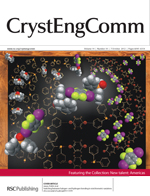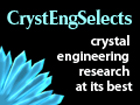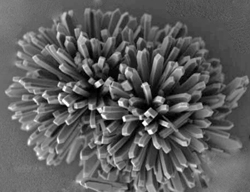This month sees the following articles in CrystEngComm that are in the top ten most accessed:-
Self assembly of shape-controlled ZnS nanostructures with novel yellow light photoluminescence and excellent hydrophobic properties
Weina Jia , Boxiang Jia , Xiang Wu and Fengyu Qu
CrystEngComm, 2012, Advance Article DOI: 10.1039/C2CE25144B
Additive controlled crystallization
Rui-Qi Song and Helmut Cölfen
CrystEngComm, 2011,13, 1249-1276 DOI: 10.1039/C0CE00419G
A VO-Seeded Approach for the Growth of Star-Shaped VO2 and V2O5 Nanocrystals: Facile Synthesis, Structural Characterization, and Elucidation of Electronic Structure
Luisa Whittaker , Jesus M. Velazquez and Sarbajit Banerjee
CrystEngComm, 2011,13, 5328-5336 DOI: 10.1039/C0CE00832J
A Mixed-Valence Lanthanide Metal-Organic Framework Templated by 2,2′-Bipyridine Formed In Situ Reaction: Synthesis, Structure, and Luminescent Properties
Bowei Cai , Yanwei Ren , Huanfeng Jiang , De Zheng , Dabin Shi , Yuying Qian and Jun Chen
CrystEngComm, 2012,14, 5285-5288 DOI: 10.1039/C2CE25160D
Single Crystalline LiMnPO4 Flowerlike Hierarchical Microstructures for Lithium-Ion Batteries
Ping Nie , Laifa Shen , Fang Zhang , Lin Chen , Haifu Deng and Xiaogang Zhang
CrystEngComm, 2012,14, 4284-4288 DOI: 10.1039/C2CE25094B
Synthesis of a 3D photochromic coordination polymer with interpenetrating arrangement: crystal engineering for electron transfer between donor and acceptor units
Yi Tan , Hengjun Chen , Jie Zhang , Shijun Liao , Jingcao Dai and Zhiyong Fu
CrystEngComm, 2012,14, 5137-5139 DOI: 10.1039/C2CE25618E
Tuning Crystal-phase and Shape of Fe2O3 Nanoparticles for Catalytic Applications
Xiaoling Mou , Xuejiao Wei , Yong Li and Wenjie Shen
CrystEngComm, 2012,14, 5107-5120 DOI: 10.1039/C2CE25109D
Five porphyrin-core-dependent metal-organic frameworks and framework-dependent fluorescent properties
Chao Zou , Ming-Hua Xie , Guo-Qiang Kong and Chuan-De Wu
CrystEngComm, 2012,14, 4850-4856 DOI: 10.1039/C2CE25357G
Discovery, Development, and Functionalization of Zr(IV)- Based Metal-Organic Frameworks
Min Kim and Seth M. Cohen
CrystEngComm, 2012,14, 4096-4104 DOI: 10.1039/C2CE06491J
An unusual (4,10)-connected 3-D metal–organic framework based on a non-planar tricarboxyl tecton and tetracadmium(II) secondary building units
Shao-Ming Fang , Min Chen , Xiao-Gang Yang , Cong Wang , Miao Du and Chun-Sen Liu
CrystEngComm, 2012,14, 5299-5304 DOI: 10.1039/C2CE25194A
Why not take a look at the articles today and blog your thoughts and comments below.
Fancy submitting an article to CrystEngComm? Then why not submit to us today or alternatively email us your suggestions.












![GA[11] Applications of halogen bonding](https://blogs.rsc.org/ce/files/2012/09/GA11.gif)







 Nacre
Nacre![GA[6] Ethambutol dibenzoate trimorphs](https://blogs.rsc.org/ce/files/2012/08/GA6.gif)
